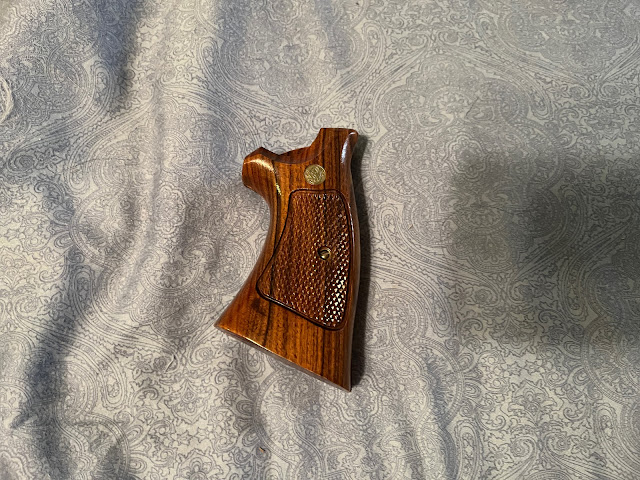Recently I acquired this Smith & Wesson model 29. The gun came with a presentation case, tools and manuals, but the factory Goncalo Alves target stocks had been replaced with a set of Pachmayrs
Whenever I buy a gun, the first thing I try to do is evaluate the condition and then determine when the gun was made.
When evaluating the condition, the main focus is the mechanical condition. Judging the condition of the finish is pretty easy, we will get to that.
Mechanically a revolver needs to be timed properly so that the cylinder will come to a stop in line with the barrel BEFORE the hammer falls.
The way to check this is simple, put a finger or thumb on the cylinder to cause a slight drag, then cock the hammer, make sure the cylinder stops before the hammer reaches full cock.
Failing this test does not mean the gun is unsafe or would blow up, it would warrant further evaluation before that determination could be made.
This gun passed that test
The gun should also be checked to make sure the cylinder opens easily and locks in place when closed. Lastly the bore should be checked for obstructions and pitting. In this case everything worked and looked as it should, but the bore was fouled and needed cleaning.
As far as the finish is concerned. The NRA has a long-established guide for determining the condition of the firearm, which has a huge impact on the value.
Here is the NRA's Modern Gun Condition Standards courtesy of the NRA Museum.
- New: Not previously sold at retail, in same condition as current factory production
- Perfect: In new condition in every aspect
- Excellent: New condition, used but little, no noticeable marring of wood or metal, bluing perfect except for muzzle or sharp edges
- Very Good: In perfect working condition, no appreciable wear on working surfaces, no corrosion or pitting, only minor surface dents or scratches.
- Good: In safe working condition, minor wear on working surfaces, no broken parts, no corrosion or pitting that interfere with the proper functioning.
- Fair: In safe working condition but well worn, perhaps requiring replacement of minor parts or adjustments, no rust, but may have corrosion pits which do not render the article unsafe or inoperable.
- Poor: Major and minor parts replaced, major replacement parts required, and extensive restoration needed; metal deeply pitted, principal lettering, numerals and design obliterate, wood badly scratched, bruised, cracked or broken, mechanically inoperative; generally undesirable as a collector's firearm.
Once cleaned and oiled this gun would be rated as Excellent (maybe Excellent plus?), there is no bluing loss on the sharp edges or muzzle and only a faint drag line on the cylinder. The color case hardening on the hammer and trigger are flawless and the gun is mechanically like new, but the gun has been fired.
There is only one thing missing: the factory grips. Now this is an easily and often replaceable part, so I don't know if that affects the grading, but it WILL affect the value.
Luckily, I had a pair of like new, period correct target stocks for this gun.
Now we move on to determining the age of the gun. On modern S&W guns (made after 1957) the model number is stamped on the inside of the crane, just above where the yoke enters the bottom of the frame.
This one is marked 29-3. This means that the gun design had been modified 3 times, this being the third version. According to the Standard Catalog of Smith & Wesson, the 29-3 appeared in 1981/1982, there is often some overlap as the factory doesn't wait until the start of a new year, nor do they throw out the parts from the previous design. This tells us the gun was made after 1981/82. The serial number (found on the bottom of the grip frame) helps us dial it in further, the N prefix with 945 starting serial numbers gives us a birthdate of 1983.
The discussion of the condition of a firearm nearly always ends with what the gun is worth.
Guns are always worth more if the box and paperwork are present. In the case of S&W revolvers of this vintage (and earlier) the presentation case, tools and paperwork have a huge impact on the value.
This gun came with the aforementioned components, but the flocking on the tray and foam was almost completely gone. This is not uncommon and is easily repaired, which I will demonstrate in another post.
What is this gun worth? As with everything, it is only worth what someone is willing to pay for it.
Once the presentation case is restored, I would guess this gun would sell for somewhere between $1000 and $1500








No comments:
Post a Comment